New: The GoPro Hero4 is now a couple of generations old and is starting to be hard to come buy if you want to buy new. We recommend you take a look at either the GoPro Hero5 Black or the new Hero6 Black. For our 10 top action camera picks, check out our up-to-date buying guide.
The action camera market is expanding at blinding speed, and the best known name in this sector is GoPro. GoPro cameras feature extensively at sports events and they're used by broadcasters like the BBC to capture spectacular wildlife footage.
GoPros and their rivals are 'POV', or 'point of view' cameras – they capture what you're doing, not necessarily what other people are doing, and what has made these cameras so groundbreaking is their small size and high-quality, high-resolution footage – and the characteristic GoPro wideangle 'look'.
• See our guide to GoPro and action cameras.
This is a camera not much larger than a matchbox which can capture 4K video at an incredible 30 fps (that's the same as the Panasonic GH4).
There's no screen, and no way of checking your composition on the camera itself, but you can connect your GoPro via Wi-Fi to a smart device to check live composition and clips. At any rate, the lens has a 170 degree angle of view so you're unlikely to miss anything.
GoPro cameras have now hit their fourth generation and the line-up has been overhauled with three new models – the GoPro Hero4 Black, GoPro Hero4 Silver and regular GoPro Hero. You can see what's new in our earlier GoProHero4 news story, but it's the top-of-the range Hero4 Black we've got our hands on here.
It goes on sale at £369/US$ 499/AU$ 639 and the headline new features are 4K video at 30fps (the Hero3+ could shoot 4K but only at 15fps) and 1080p at 120fps – that's full HD in 1/4-speed slow motion. This is a crazy amount of power in a device that costs about the same as an entry-level DSLR or compact system camera.
Other new features include Bluetooth support, not just Wi-Fi, and the ability to tag your best footage as you shoot it.
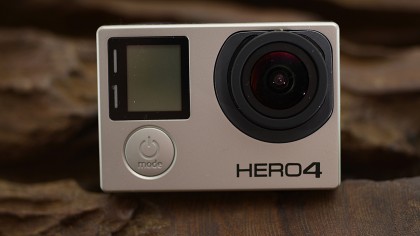
Aesthetically, the Hero4 Black looks much the same as the Hero3+, with the familiar GoPro box form and dimensions. This means that the standard waterproof housing remains the same and is included with the camera when purchased. But once you start using it you realise there have been a few significant changes to the design which make a big difference.
Some are fairly minor – the camera status and Wi-Fi lights that were on the front before are now two small illuminated slits to the left of the LED screen.
And on the right hand side of the body the old direct access Wi-Fi button now becomes the settings button – and if you hold down for a couple of seconds it will still enable you to toggle Wi-Fi on and off.
This new settings button is part of the overhauled navigation system, which is a vast improvement and actually makes using the camera far more intuitive than the previous version.
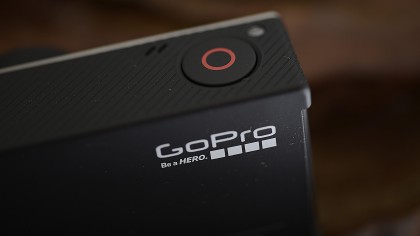
Finally, the battery compartment is no longer accessed through the back of the camera. It’s now located in the base, and the battery type also changes from 3.7v 1180mAh to 3.8v 1160mAh. More importantly, it’s much easier to swap out in the field than before.
As with previous models there’s a connection on the back for a screen. On the side under a protective flap are two connectors that enable direct connection to HDMI and USB along with a Micro SD card slot.
The GoPro Hero 4 is a camera of two parts, with the camera itself and a protective waterproof housing. The housing can easily be removed and replaced with other housing designs that offer different levels of protection and features depending on the activity you’re doing.
The GoPro Hero4 Black comes supplied with a standard housing in the box, this is a good general purpose case, providing waterproofing up to 40m. There are further housings such as the dive housing (the standard housing for the Hero3) that is waterproof up to 60m, and a selection of skeleton housings for use with drones or the various harnesses.
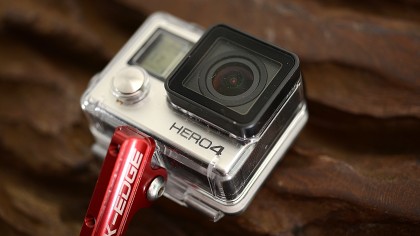
Using either of the waterproof housings does add bulk, but when compared with action cameras of a similar design such as the Toshiba Camileo X-Sport, the GoPro is still compact.
These housings are at the heart of GoPro’s versatility and feature the standard GoPro mount, this is widely supported by third party manufacturers, so there’s an abundance of accessories out there. This means that if there is something that you would like to attach your GoPro to, then there’s likely to be a mount out there for it. The GoPro mount is extremely secure and when compared to mounts from other action camera manufacturers, you can really see the benefit of the design. It enables the camera to be bolted down tightly without wobble, which might seem like a small ask but is surprising difficult with some mount designs.
• See our Top 10 GoPro Accessories feature.
The accessories we used, included the GoPro handlebar mount, K-Edge Go Big Pro handlebar mount and DJI Phantom quadcopter, fitted to the GoPro’s housing easily and once tightened held the camera in place securely, helping to prevent vibrations which can plague action camera footage. The housing and mounts were also tough enough to survive a heavy mountain bike crash better than its user. With the bike’s front wheel being a complete write off and its rider having to be patched up in the local A&E, the GoPro Hero4 Black, mounts and case all survived with a coating of mud and leaves.
We tested the camera on a relatively cold morning and the casing suffered from steaming up a little on the inside when moving from a cold to warm environment. This has been a common issue with the waterproof cases, but is easily solved, and GoPro suggests you use a small moisture strip, that can be bought separately, and can be easily fitted into the case.
Whichever case you choose they all allow direct access to the buttons so you are able to easily navigate the various menus, change setting and set the camera recording.
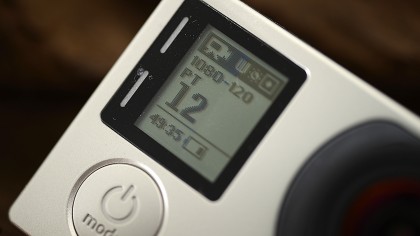
Operation of the camera is straight forward with three buttons enabling complete access to the menu system and settings, as well as the operation of the camera. There have been a few changes since the Hero 3+ to these navigation controls and while the buttons are still in the same position as previous GoPro versions, the way in which they work has been slightly tweaked, which makes finding your way around quicker and more intuitive.
The large on/off button is position on the front of the camera and also acts as the mode button once the camera is switched on. This enables you to switch between Video, Photo, Multi-Shot, Playback and Setup. With a mode selected the options for that mode can then be accessed by a single press of the settings button on the side of the camera. The Mode button is then used to scroll through the settings and the button on top is used to make your selection.
Finally once you’ve exited the settings the button on top of the camera starts or stops recording.
Smart features
Connecting to a smart device is straightforward, and there’s an app available for both iOS and Android devices. Once Wi-Fi is activated a blue light flashes on the front. The GoPro can then be selected on your smart device from the list of usual Wi-Fi connections, and once passwords are entered it’s just a case of loading up the app.
The app is slickly designed and enables you to connect and control your GoPro with selectable live feed and the ability to review footage and stills direct from the camera. When not connected to the camera and your smart device is online you can also get inspiration from other GoPro users through the GoPro channel.
Using the app is straightforward and compared to apps used by other action cameras such as the iON Air Pro it really shows the GoPro developers have a good understanding of how the camera and Wi-Fi connection will be used.
Options are large, settings are easy to find and there’s enough within the app to make you feel that it’s by no means an after thought.
The Hero 3+ upgraded the speed of it’s Wi-Fi hardware and this speed is really apparent in the Hero 4 Black enabling the smooth playback of footage. Unlike some competitors that struggle with constantly dropping frames, pausing or loosing connection.
Video tasty
Video is of course what GoPro’s is known for and to get started all you really need to do is switch on and hit the record button. But unlike many action cameras GoPro gives you choice and this is both a strength and weakness of the design.
For those who know about video and how the footage they’re shooting will be used and edited, the wealth of capture options is an absolute dream come true, however for the average user the volume of options for resolution, frame rates can all be a bit bewildering.
For example there are 12 resolutions and a variety of frame rates to choose from, ranging from high resolution 4K (3840×2160) at either 24, 25 or 30 frames a second (fps) to low resolution WVGA (848×480) at 240 FPS.
Aside from the obvious size difference of the different resolutions the part that is of most interest to extreme sports enthusiasts is the frame rate. HD or 1080p resolution is at present the most popular choice and as such will probably be the most used option for the GoPro. Usually 1080p high definition video is recorded at a respectable 29.7 fps which provides nice smooth playback. The GoPro Hero4 enables HD recording at 120, 90, 60, 50, 48, 30, 25, 24 fps this means that with the highest frame rate selected for recording of, 120 fps when edited down to 29.7 fps for playback the footage will produce smooth slow motion, a feature that is becoming increasingly popular with the extreme sports sector.
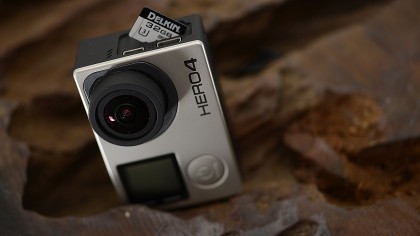
In order to select 1080P at 120 fps a short ritual of button pressing must be followed; video mode must firstly be selected, then the settings button on the side pressed. The mode button is then used to find the option, in this case the resolution that you want which is then selected with the top button. The mode button is then used to scroll through the resolution options and once 1080p is showing the top button is used to select. The same process is then used to set the frame rate or any other options that needs changing. All fine if you know what you’re doing otherwise a little complex, but it’s far easier than the similar but slightly different system of the Hero3.
The GoPro captures a 170 degree point of view and with an f/2.8 lens almost everything in front of the lens is captured, so as long as the camera is roughly pointing in the right direction you can be pretty sure that you’re going to capture something.. There are options to change the point of view to narrow in some resolution settings, but for the best quality footage we found it was best to stick to the standard wide angled view.
Our test day proved to be a typical late autumn day, so despite aspirations to hit the surf, with temperatures just tipping zero and a light frost and later drizzle, we headed into the forest to test the camera with a bit of off-roading.
Setting the camera up and attaching to the bars of a mountain bike couldn’t have been easier, even in the cold and wet when wearing gloves. Operation was simple and a flashing red light indicated that all systems where go.
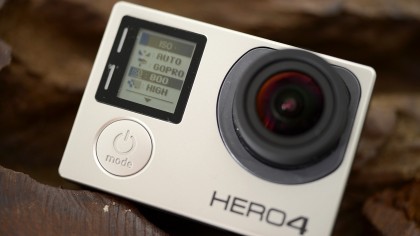
The small LCD on the front gave a brief breakdown of the settings that were being used and the length of recording time that had lapsed, a handy indicator that reassures you that footage is being captured.
During the off-roading and later using the Hero4 on a quadcopter drone we switched between resolutions and frame rates to check on the quality of the footage.
Conditions where at best murky, so while the footage looked dull this was more due to the day than the quality of capture.
Switching between resolutions showed a high level of detail was captured in each setting, and despite the cameras sensitivity being pushed to ISO 1600, due to the low light, noise was apparent but handled well.
In the lowest of light conditions the colour rendition did suffer with the automatic white balance making changes quickly, but generally the camera captured natural and well saturated colour tones.
The GoPro has spot metering and exposure compensation options, but left to its own devices it does an excellent job. Moving the camera quickly from light to dark showed the exposure system was able to keep up with the changes in light, adjusting and making exposure changes smoothly.
Video quality
Looking at the 4K footage and comparing this directly against that of the GoPro Hero 3+ the improvement in quality from 15 to 30 fps is instantly apparent, with the videos motion looking far smoother than in the previous model and showing that in a camera of this size the 4K ability isn’t just a novelty but a feature that could and should be used.
Using the more common resolution of 1080p at 30 fps, 50 fps and 120fps showed the most exciting results. The footage at each rate looked smooth on screen but the real revelation came when the footage was edited through the Final Cut Pro X and adjusted to a base frame rate of 29.7 fps, stretching the footage over four seconds.
The result of the 30 fps footage looked stuttered as you’d imagine, and there was only a slight improvement in the 50 fps clips. Looking at the footage capture at 120 fps and slowed to 29.7 fps showed smooth quality footage that retains detail and colour and most importantly smoothness of motion.
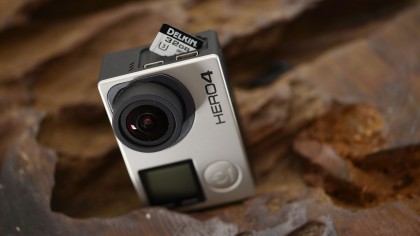
The lens of GoPro was improved in the Hero 3+ and in the latest version the lens captures good quality footage with the distinct action camera look caused by the huge field of view and distortion.
However for a lens that captures 170 degree field of view the distortion isn’t as pronounced as you’d expect ,with footage in the centre of the frame kept within acceptable limits of distortion and major distortion only effecting the edges.
Chromatic aberration at the mid to edge frame is apparent in high contrast situations especially in the footage when riding or flying through trees.
Sound and software
As with the GoPro Hero 3 and 3+ the Hero 4 features the high quality ProTune feature that gives you more control over the quality and output of your camera. An ideal tool if you’re wanting to match up footage from several different cameras. We’ll take a closer look at this is the near future.
The GoPro has a built in microphone which captures the ambient noise well. It’s is by no means broadcast quality but does the job. There is the option to connect an external microphone through a USB which will be of interest to those wanting to buy the Music version of the GoPro Hero 4 Black. We have yet to test this feature but will bring you the results when we do.
The all new battery lasts for a good hour and half of shooting time, although make sure that the Wi-Fi connection is switched off as this will reduce operating times significantly.
The camera isn’t the end of the story and one of the features that really makes GoPro stand out from the rest is the GoPro Studio software. This is available for Mac and PC and enables you to edit the footage that you’ve captured. The software itself is a direct free download from the GoPro website and once downloaded enables you to get stuck in and creating.
The organisation and edit tools are pretty simple but they let you get editing straight away. There are more advanced features that enable you to make the most from the fast frame rates by speeding up and slowing down footage, and as an editing package it’s really a great place to start. It also supports most Canon and Nikon video files which is handy as neither company supply video editing software with their cameras.
Note that these are hosted on YouTube and won’t display at their full size by default – use the YouTube Settings pop-up to change the resolution.
Filmed at 120fps in low light.
The Hero4 Black’s exposure system handles transitions from shade to sun quickly and easily.
The previous clip was shot at 120fps – here it is played back at 30fps in 4x slow motion.
A slow panning shot showing the Hero4 Black’s ability to deal with changing exposure.
This static shot shows the level of detail and dynamic range the GoPro Hero4 can capture.
A sample clip shot in a low-light high-contrast situation.
GoPro is the main player in the action camera market, and while the design strikes many as boxy and simplistic, when compared against other action cameras you realise there’s a reason for GoPro’s success.
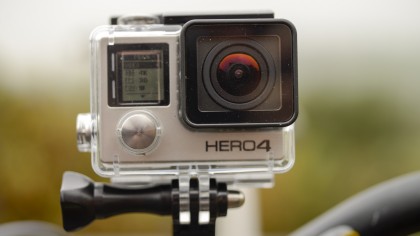
This is a small matchbox sized camera that can go anywhere and shoot broadcast-quality footage. The range of mounts that are available out there enable the camera to be mounted to just about anything, and the mount design while simple enables the camera to be attached firmly without play.
The navigation system overhaul makes settings and modes changes easier than ever, so there is never a reason to miss the action. The design might not have changed a great deal and the upgrades over the Hero 3+ might seem like refinements, but what the 120 frames per second and greater processing speeds mean is that GoPro has once again increased its desirability in an increasingly competitive action cameras arena.
We liked
The Hero4 Black is tough, adaptable and shoots really high quality video. The control interface has been improved over previous versions and it’s now a lot easier to use – it’s steady improvement like this that makes a great product, not just headline new features. Having said that, the ability to shoot 4K video at 30fps is an important step forward, but it’s the ability to shoot full HD at 120fps that’s perhaps the most amazing advance.
We disliked
Some will prefer ‘bullet’ style action cameras over the boxy GoPro. They’re more discreet and, in a lot of cases, simpler to operate. The biggest flaw with the GoPro Hero4 Black is its slow startup time – you have to press and hold the power button for several seconds before the camera is ready to start shooting, and that could lead to some missed opportunities and a good deal of frustration.
Final verdict
Despite increasing competition from rivals, the GoPro is still the definitive action cam, and the Hero4 Black produces broadcast-quality video at a price even casual adventure fans can afford.
Extreme sports enthusiasts will love the out of the box usability of the GoPro Hero4 Black. You charge it, fix it on, record, upload it and you’re done. Those who want more can delve into the settings to make the most of the new frame rates and resolutions, and creatives will love the versatility that features like ProTune promise.